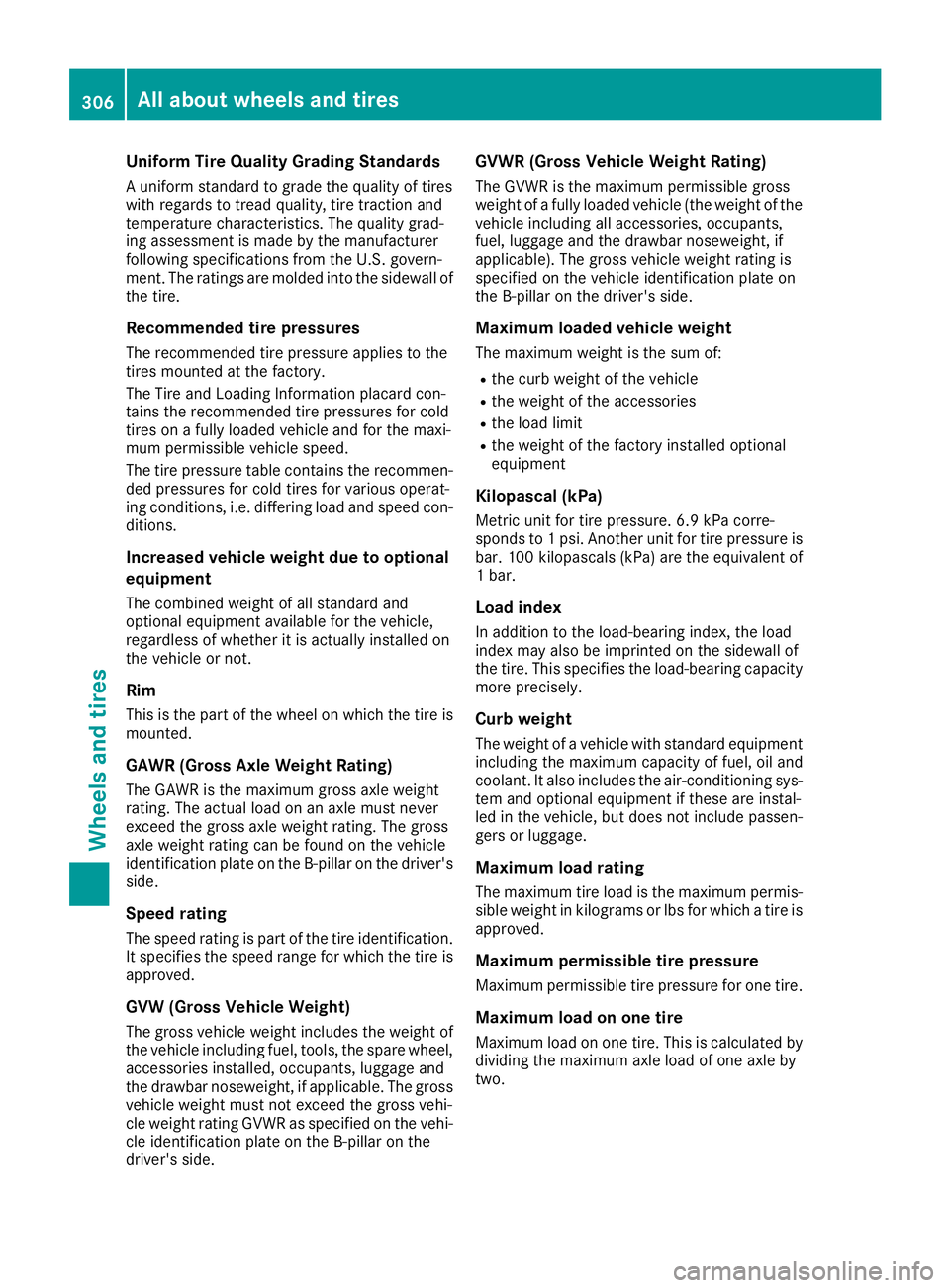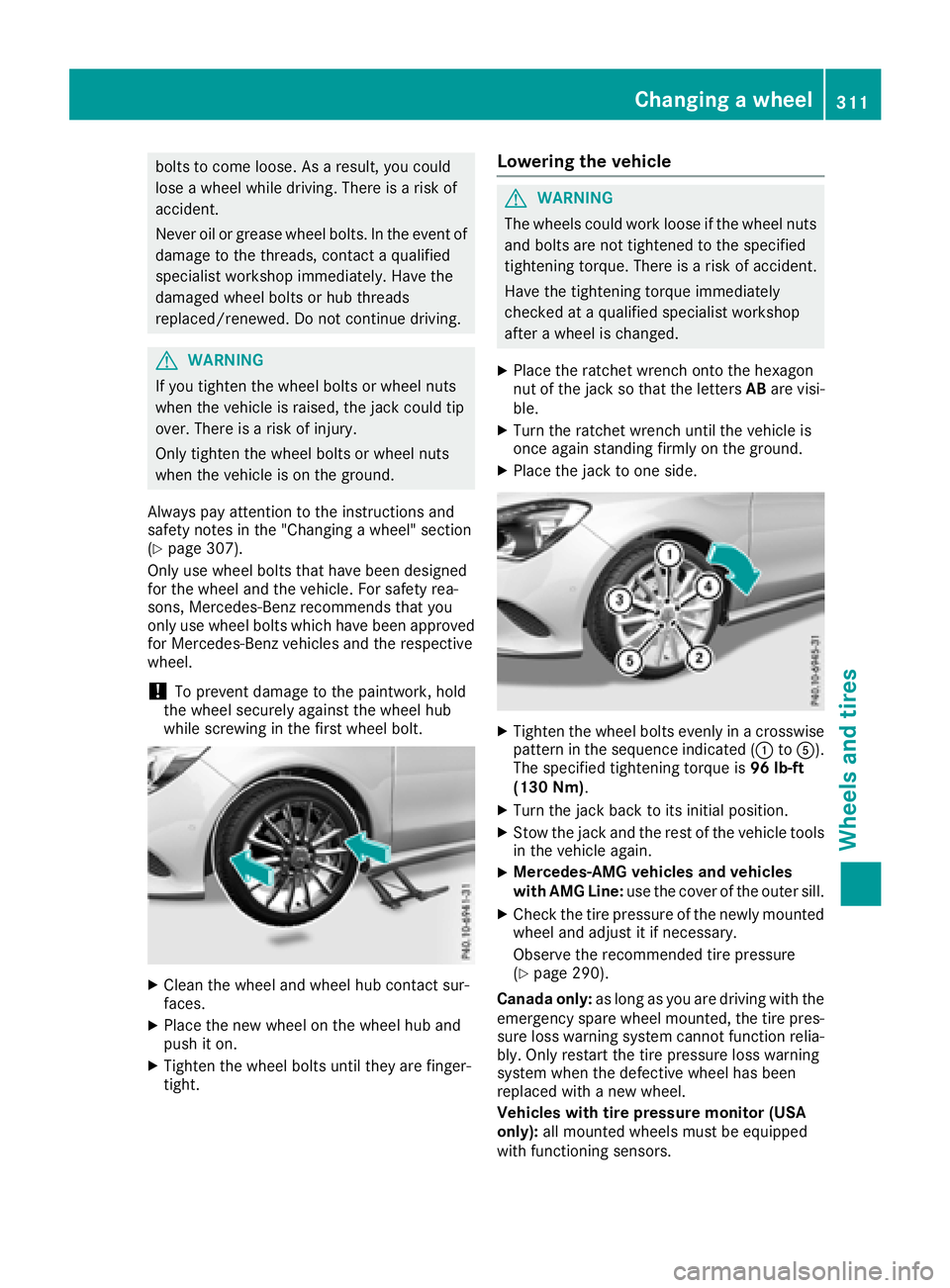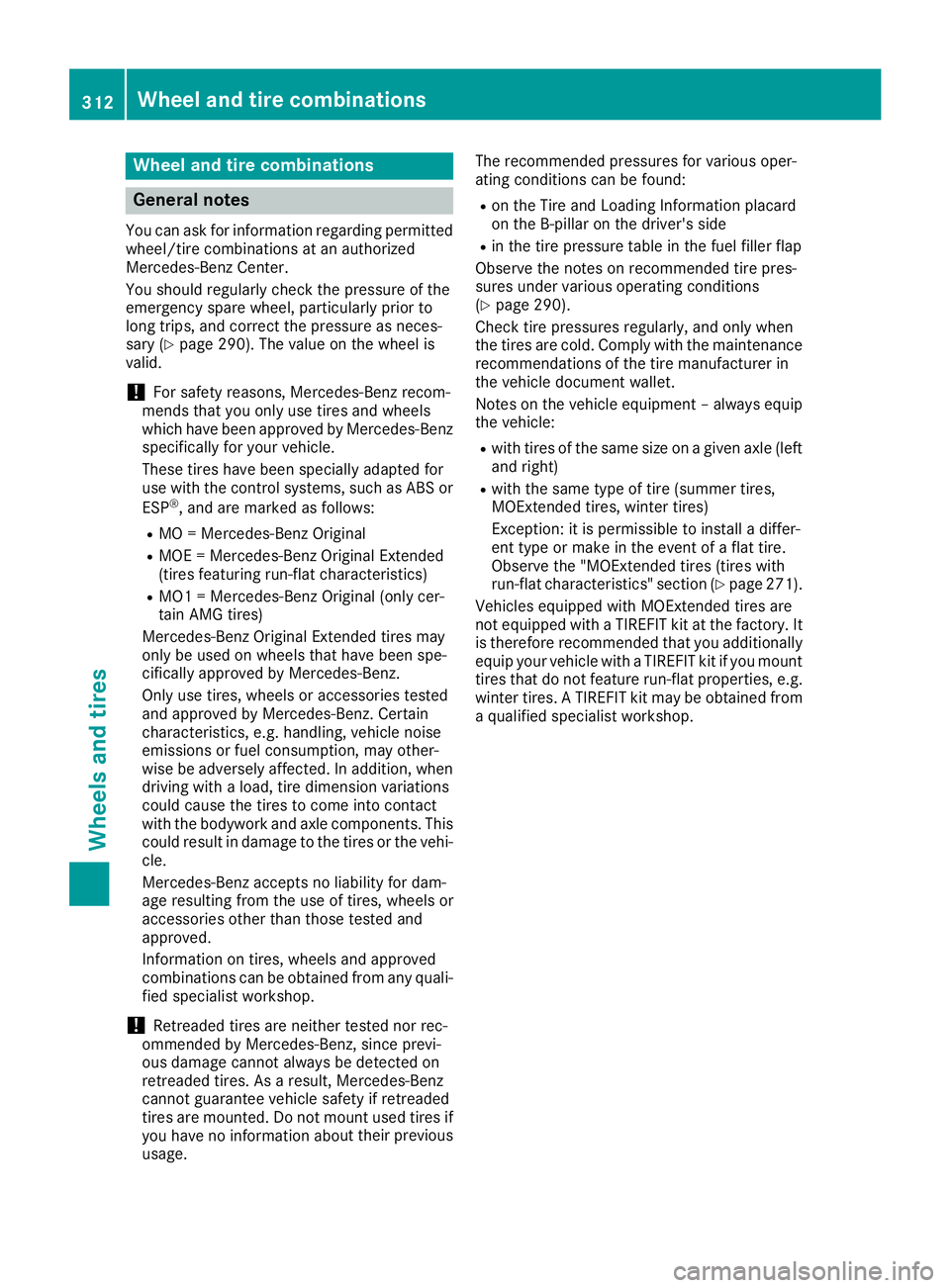2018 MERCEDES-BENZ CLA COUPE spare wheel
[x] Cancel search: spare wheelPage 308 of 326

Uniform TireQualityG rading Standards
Aunifor mstandard to grade the quality of tires
with regards to tread quality, tire traction and
temperature characteristics. The quality grad-
ing assessmentism ade by the manufacturer
following specification sfrom the U.S .govern-
ment .The ratings are molded int othe sidewall of
the tire.
Recommended tir epressures
The recommended tire pressure applies to the
tires mounted at the factory.
The Tire and Loading Information placard con-
tains the recommended tire pressures for cold
tires on afully loaded vehicle and for the maxi-
mum permissible vehicle speed.
The tire pressure table contains the recommen-
ded pressures for cold tires for various operat-
ing conditions, i.e. differingl oad and speed con-
ditions.
Increased vehicle weight due to optional
equipment
The combined weight of all standard and
optional equipment available for the vehicle,
regardless of whether it is actually installed on
the vehicle or not.
Rim
This is the part of the wheel on which the tire is
mounted.
GAWR (Gross Axle Weight Rating)
The GAWR is the maximum gross axle weight
rating. The actual load on an axle must never
exceed the gross axle weight rating. The gross
axle weight ratin gcan be found on the vehicle
identification plate on the B-pillar on the driver's
side.
Speed rating
The speed ratin gispart of the tire identification.
It specifies the speed range for which the tire is
approved.
GVW (Gross Vehicle Weight)
The gross vehicle weight includes the weight of
the vehicle includin gfuel, tools, the spare wheel,
accessories installed, occupants, luggage and
the drawbar noseweight ,ifapplicable. The gross
vehicle weight must not exceed the gross vehi-
cle weight ratin gGVWR as specified on the vehi-
cle identification plate on the B-pillar on the
driver'ss ide.
GVWR(Gross Vehicle Weight Rating)
The GVWR is the maximum permissible gross
weight of afully loaded vehicle (the weight of the
vehicle includin gall accessories, occupants,
fuel, luggage and the drawbar n
oseweight
,if
applicable). The gross vehicle weight ratin gis
specified on the vehicle identification plate on
the B-pillar on the driver'ss ide.
Maximum loaded vehicle weight
The maximum weight is the sum of:
Rthe curb weight of the vehicle
Rthe weight of the accessories
Rthe load limit
Rthe weight of the factory installed optional
equipment
Kilopascal (kPa)
Metric unit for tire pressure. 6.9 kPa corre-
sponds to1psi. Another unit for tire pressure is
bar. 100 kilopascals (kPa) are the equivalent of
1b ar.
Load index
In addition to the load-bearin gindex ,the load
index may also be imprinted on the sidewall of
the tire. This specifies the load-bearin gcapacity
more precisely.
Curb weight
The weight of avehicle with standard equipment
includin gthe maximum capacityoff uel, oil and
coolant .Italso includes the air-conditionin gsys-
tem and optional equipment if these are instal-
led in the vehicle, but does not include passen-
gers or luggage.
Maximum load rating
The maximum tire load is the maximum permis-
sible weight in kilogram sorlbs for which atire is
approved.
Maximum permissible tir epressure
Maximum permissible tire pressure for one tire.
Maximum load on one tire
Maximum load on one tire. This is calculated by
dividing the maximum axle load of one axle by
two.
306All about wheels and tires
Wheels and tires
Page 313 of 326

bolts to come loose. Asaresult, you could
lose awheel while driving .There is arisk of
accident.
Never oil or grease wheel bolts. In the event of
damage to the threads, contact aqualified
specialist workshop immediately. Have the
damaged wheel bolts or hub threads
replaced/renewed. Do not continue driving.
GWARNING
If you tighten the wheel bolts or wheel nuts
when the vehicle is raised, the jack could tip
over. There is arisk of injury.
Only tighten the wheel bolts or wheel nuts
when the vehicle is on the ground.
Always pay attention to the instructions and
safety notes in the "Changing awheel" section
(
Ypage 307).
Only use wheel bolts that have been designed
for the wheel and the vehicle. For safety rea-
sons, Mercedes-Benz recommends that you
only use wheel bolts which have been approved for Mercedes-Benz vehicles and the respective
wheel.
!To preventd amage to the paintwork, hold
the wheel securely against the wheel hub
while screwingint he first wheel bolt.
XClean the wheel and wheel hub contact sur-
faces.
XPlace the new wheel on the wheel hub and
push it on.
XTighten the wheel bolts until they are finger-
tight.
Lowering the vehicle
GWARNING
The wheels could work loose if the wheel nuts and bolts are not tightened to the specified
tightenin gtorque. There is arisk of accident.
Have the tightenin gtorque immediately
checked at aqualified specialist workshop
after awheel is changed.
XPlace the ratchet wrenc hontot he hexagon
nut of the jack so that the letters ABare visi-
ble.
XTurn the ratchet wrenc huntil the vehicle is
onc eagain standing firmly on the ground.
XPlace the jack to one side.
XTighten the wheel bolts evenly in acrosswise
pattern in the sequence indicated (: toA).
The specified tightenin gtorque is 96 lb-ft
(130 Nm) .
XTurn the jack back to its initial position.
XStow the jack and the rest of the vehicle tools
in the vehicle again.
XMercedes-AMG vehicles and vehicles
with AMG Line: use the cover of the outer sill.
XCheck the tire pressure of the newly mounted
wheel and adjust it if necessary.
Observe the recommended tire pressure
(
Ypage 290).
Canadao nly:as long as you are driving with the
emergency spare wheel mounted, the tire pres-
sure loss warning system cannot function relia-
bly. Only restart the tire pressure loss warning
system when the defective wheel has been
replaced with anew wheel.
Vehicles with tir epressure monitor (USA
only): all mounted wheels must be equipped
with functioning sensors.
Changing awheel311
Wheels and tires
Z
Page 314 of 326

Wheeland tire combinations
General notes
You can ask for information regarding permitted
wheel/tire combinations at an authorized
Mercedes-Benz Center.
You should regularl ycheck the pressure of the
emergency spare wheel, particularly priort o
long trips, and correct the pressure as neces-
sary (
Ypag e290). The valu eonthe wheel is
valid.
!For safety reasons, Mercedes-Benz recom-
mends that you only use tires and wheels
which have been approved by Mercedes-Benz
specifically for you rvehicle.
These tires have been speciall yadapted for
use with the control systems, such as ABS or
ESP
®,a nd are marked as follows:
RMO = Mercedes-Benz Original
RMOE = Mercedes-Benz Original Extended
(tires featuring run-fla tcharacteristics)
RMO1 = Mercedes-Benz Original (only cer-
tain AMG tires)
Mercedes-Benz Original Extended tires may
only be use donwheels that have been spe-
cifically approved by Mercedes-Benz.
Only use tires, wheels or accessories tested
and approved by Mercedes-Benz. Certain
characteristics, e.g. handling, vehiclen oise
emissions or fuel consumption, may other-
wis ebea dversely affected .Inaddition, when
driving with aload, tire dimension variations
coul dcaus ethe tires to come into contact
with the bodywork and axle components. This
coul dresult in damage to the tires or the vehi-
cle.
Mercedes-Benz accepts no liability for dam-
age resulting from the use of tires, wheels or
accessories other than those tested and
approved.
Informatio nontires, wheels and approved
combinations can be obtained from any quali-
fied specialist workshop.
!Retreaded tires are neither tested nor rec-
ommendedbyM ercedes-Benz, since previ-
ous damage cannot alway sbedetected on
retreaded tires. As aresult, Mercedes-Benz
cannot guarantee vehicles afety if retreaded
tires are mounted .Donot mount use dtires if
you have no information abo ut thei
r previous
usage. The recommendedp
ressures for various oper-
ating conditions can be found:
Ron the Tire and Loading Informatio nplacard
on the B-pillar on the driver's side
Rin the tire pressure tabl einthe fuel filler flap
Observe the notes on recommendedt ire pres-
sure sunder various operating conditions
(
Ypag e290).
Check tire pressures regularly,a nd only when
the tires are cold. Comply with the maintenance
recommendations of the tire manufacturer in
the vehicled ocument wallet.
Notes on the vehiclee quipment–alway sequip
the vehicle:
Rwith tires of the same size on agivena xle (left
and right)
Rwith the same type of tire (summer tires,
MOExtended tires, winter tires)
Exception: it is permissible to instal ladiffer-
ent type or make in the event of aflat tire.
Observe the "MOExtended tires (tires with
run-fla tcharacteristics" section (
Ypag e271).
Vehicles equipped with MOExtended tires are
not equipped with aTIREFIT kit at the factory.I t
is therefore recommendedt hat you additionally
equip you rvehiclew ithaTIREFIT kit if you mount
tires that do not feature run-fla tproperties, e.g.
winter tires. ATIREFIT kit may be obtained from
aq ualified specialist workshop.
312Wheela nd tire combinations
Wheels and tires